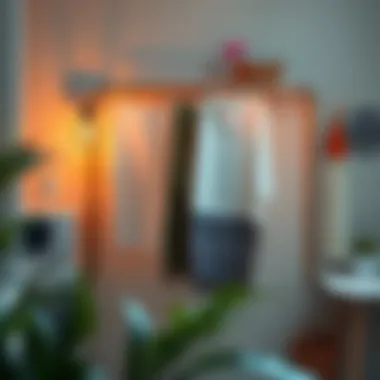Comprehensive Guide to Laundry Drying Lines


Intro
Laundry drying lines are often an overlooked aspect of household chores, yet they play a vital role in the efficiency and aesthetics of daily laundry routines. Traditionally, the act of drying clothes has been relegated to hidden corners of our homes or to outdoor spaces where they might look out of place. However, recent shifts in design philosophy, environmental considerations, and the rise of minimalist living have put laundry drying lines back in the spotlight. By combining form and function, these lines are now making their way into contemporary home design, ensuring they serve both practical purposes and contribute to the overall style of a space.
Homeowners, designers, and DIY enthusiasts will find value in understanding how these innovations are reshaping the laundry experience. From materials to installation techniques, this guide sheds light on everything that one needs to know. So, let’s embark on this journey to explore the world of laundry drying lines, where tradition meets modernity and functionality harmonizes with aesthetics.
Furniture Styles and Trends
Modern vs. Traditional: Understanding the Aesthetics
When it comes to laundry drying lines, the choice between modern and traditional styles can greatly influence a home's visual language. Modern drying lines often embrace sleek, minimal designs. They might utilize materials like stainless steel and durable synthetics, offering a fresh look that fits with contemporary aesthetics. On the other hand, traditional drying lines tend to celebrate craftsmanship and the warmth of natural materials like wood.
- Modern Lines: These may include retractable wall-mounted lines or free-standing units, often finished in clean, neutral tones. Their design usually aligns with the streamlined look that characterizes current architectural trends.
- Traditional Lines: Classic wooden drying racks or pulley systems invite nostalgia. These elements can easily blend into more rustic or vintage-styled homes, adding a touch of charm and character.
"The balance between utility and appearance is crucial. A well-placed drying line can enhance the beauty of a space rather than detract from it."
Color and Material Trends: What's In and What's Out
Selecting the right color and material for a laundry drying line can enhance its visual appeal while also serving practical purposes. In recent years, there’s been a noticeable shift towards environmentally-friendly materials. Bamboo drying racks, for instance, are gaining traction due to their renewable nature and artistic finish.
- In Trends:
- Out Trends:
- Bamboo: Not only eco-friendly but also known for its durability and aesthetic value.
- Pastel Colors: Soft hues like soft blue and mint green can add a refreshing touch to the often drab laundry space.
- Metallic Accents: Brass or copper fixtures offer a luxurious touch, captivating attention while ensuring longevity.
- Overly ornate designs that clutter the space.
- Bright primary colors that take away from the serenity typically sought in laundry areas.
Furniture Care and Maintenance
Tips for Prolonging the Life of Your Furniture
It’s not just about having the right style; knowing how to care for your drying line also matters. Regular maintenance can keep your drying solutions looking sharp and functioning well. Here are a few quick tips:
- Clean Regularly: Dust and dirt can accumulate on both modern and traditional drying lines. Periodic cleaning prevents buildup and retains the freshness of the material.
- Protect From The Elements: If your drying line is outdoors, consider using protective covers during harsh weather to prevent degradation of materials.
- Inspect for Damage: Regularly check for loose screws or weak points and address issues before they become bigger headaches.
DIY Repair Hacks for Common Furniture Issues
Sometimes things go awry. It’s best to be prepared. Here are some simple DIY fixes:
- Fixing a Wobbly Rack: Sometimes, stability can be an issue. Use wood glue for minor repairs on wooden racks, or check that all screws on metal frames are tightened.
- Refreshing Paint: If your drying line is looking a little worn, a quick coat of spray paint can rejuvenate its appearance. Opt for exterior-safe paint for outdoors!
Understanding Laundry Drying Lines
Understanding laundry drying lines requires an examination of not just what they are, but why they are vital in today’s world, particularly in the context of sustainability and efficiency in home management. Drying lines have transitioned from being mere conveniences to essential components that reflect both functional and aesthetic choices made by homeowners. A comprehensive grasp of these drying systems is important, as it informs decisions on which type best serves a household’s needs.
The significance of laundry drying lines extends beyond their primary function of drying clothes. By opting to air dry rather than relying solely on electric dryers, individuals embrace eco-friendliness, contributing to reduced energy consumption and lower electricity bills. Ultimately, this choice leads to a long-term impact on both finances and the environment. Furthermore, according to the U.S. Department of Energy, a clothes dryer uses more electricity than any other household appliance. Therefore, understanding the various aspects of drying lines not only promotes environmental awareness but also encourages smarter financial decisions.
Definition and Purpose
A laundry drying line, at its core, is a system designed to suspend wet garments for drying by natural air circulation. These lines come in various forms, catering to different spaces and preferences, including outdoor clotheslines, retractable lines, and indoor drying racks. Their fundamental purpose is straightforward: to facilitate the drying of laundry without the mechanical means of a dryer. However, this basic definition belies the myriad of benefits that these lines offer.
Using a laundry drying line allows clothes to retain their texture and color without the harsh effects of high heat, which can wear down fabrics over time. Furthermore, many individuals find that air-dried clothes carry a freshness that cannot be replicated by mechanical systems—akin to that delightful scent of a spring breeze. This wholesome approach is gaining traction among homeowner demographics who prioritize quality and sustainability in their lifestyle choices.
Historical Context
Historically, drying clothes on lines is a practice that goes back centuries, steeped deeply in human culture. Before the advent of electric dryers, laundry drying lines were prevalent in every household. Consider the rustic charm of rural life where aromatic linens were a common sight, flapping gently in the wind. In communities across Europe, Asia, and beyond, clotheslines symbolized a connection between domestic chores and the natural world.
As societies modernized, the invention of electric dryers offered convenience, yet the traditional lines remained integral, especially in regions where climate conditions permit outdoor drying year-round. In many cultures, hanging clothes outside has remained a social practice—a moment of respite amidst daily activities. The true essence of understanding laundry drying lines lies in grasping their place in both past and present lifestyles, illustrating how something so simple can be woven into the fabric of everyday life.
In recent years, alongside the push for sustainable practices, there has been a resurgence in the appreciation for drying lines, blending a sense of nostalgia with the modern mandate for environmental responsibility.
"In every piece of laundry hung outside, there’s a story of sustainability waiting to unfold."
With a deeper comprehension of what laundry drying lines are and their importance, homeowners can make choices that honor both tradition and innovation in their laundry routines.
Types of Laundry Drying Lines
Understanding the variety of laundry drying lines is crucial for anyone looking to optimize their laundry experience. Each type comes with its unique benefits and considerations, which can significantly impact the effectiveness and convenience of drying clothes. By recognizing these differences, homeowners and DIY enthusiasts can make more informed decisions that align with their specific needs and space constraints.
Traditional Clotheslines


Traditional clotheslines evoke a sense of nostalgia, representing a time when air-drying was not just a choice but a necessity. They typically consist of ropes or wires stretched between two poles or trees in a yard or garden. The charm of a traditional clothesline lies in its simplicity and effectiveness.
Using a traditional line encourages users to partake in a sustainable practice, reducing energy consumption associated with tumble dryers. Benefits of this method include:
- Fresh Air Scent: Clothes dried outdoor tend to smell fresher, infused with the natural scent of the environment.
- Cost-Effective: With no electricity required, it’s an economical option.
- Space Utilization: Ideal for large yards or gardens.
However, they do have drawbacks, including vulnerability to weather conditions and the need for ample outdoor space. For communities where outdoor drying is restricted or for homes in urban settings, this option may not be feasible. Yet, many find a joyful sense of connection to nature when hanging clothes in the open air.
Retractable Drying Lines
Retractable drying lines offer a modern twist on the traditional concept, especially suitable for those with limited outdoor space. They can be extended when needed and retracted to save space when not in use. These lines typically attach to walls or fences and provide a practical solution for various environments.
The key advantages of retractable drying lines are:
- Space-Saving: Ideal for small backyards or balconies where having a permanent installation isn’t possible.
- Ease of Use: Users can set these up quickly, making them convenient for quick laundry days.
- Versatile Lengths: Many models allow adjustment according to the load.
Notable brands like Brabantia and Leifheit offer popular models, strengthening the appeal of these compact drying solutions. However, proper installation is important; if installed haphazardly, they might not operate efficiently, leading to user frustration.
Indoor Drying Solutions
Indoor drying solutions appear as a lifesaver for urban dwellers or those facing inclement weather conditions. They include drying racks, foldable hangers, and specialized indoor drying cabinets. By utilizing these tools, individuals can dry their laundry without exposing it to outdoor elements.
Benefits of indoor drying solutions encapsulate:
- Weather Independence: No more worries about rain ruining your freshly washed clothes.
- Space Optimization: Many models collapse for storage, making them suitable for cozy apartments.
- Controlled Environment: Helps in minimizing the time taken for clothes to dry in humid seasons.
Nonetheless, care must be taken with ventilation to prevent mold and unpleasant odors from settling in the home. Therefore, creating an airy environment is essential for maintaining the integrity of the dried garments.
Wall-Mounted Drying Racks
Wall-mounted drying racks introduce a subtle yet effective option for air-drying clothes. They can be installed in various spaces, including laundry rooms, bathrooms, or even kitchen areas, depending on the design. These racks fold down when not in use, preserving space but providing ample drying area when deployed.
Some perks associated with wall-mounted drying racks include:
- Efficiency: Maximizes vertical space, essential for homes with limited square footage.
- Aesthetic Value: Many designs incorporate beautiful woods or metals, adding to the home’s décor.
- Winter Utility: Offers a way to dry clothes indoors during colder months without a substantial energy cost.
However, proper planning and placement are key to ensuring convenience and accessibility. Homeowners must think about the reach of these drying racks, making them easy enough to use without climbing on furniture or straining to reach the top.
By recognizing the various types of laundry drying lines available, homeowners can choose solutions that not only fit their lifestyle but also enhance their drying efficiency and overall experience.
Material Considerations
When it comes to laundry drying lines, the choice of materials is of paramount importance. The material considerations section will delve into elements that can make or break the drying efficiency and longevity of your clotheslines. Homeowners and designers alike must weigh the options carefully, as materials not only determine durability but also functionality and environmental impact. For instance, the weather-resistant properties of the material directly affect how well it performs outdoors, while eco-friendly options cater to a growing demand for sustainable living solutions.
Durable Materials for Outdoor Use
Considering that clotheslines are predominantly exposed to the elements, selecting durable materials for outdoor use is crucial. Common materials include:
- Stainless Steel: Renowned for its remarkable strength and resistance to rust, stainless steel stands out as a top-tier choice for outdoor drying lines. Its robust nature ensures that it can withstand harsh weather conditions, making it perfect for long-term use.
- Aluminum: Lightweight yet surprisingly strong, aluminum is another fantastic candidate. It won’t corrode, ensuring your drying line remains functional despite exposure to moisture. Moreover, it’s easy to install and maneuver.
- Polyester Composite: This material is gaining traction for its resistance to UV rays. Unlike wood, which can warp and degrade over time, these composites maintain their integrity and color exposure to sunlight.
- High-Density Polyethylene (HDPE): Often used in retractable options, HDPE is both flexible and tough, allowing for creative designs without sacrificing strength.
In choosing the right material, pay attention to maintenance needs as well. Stainless steel may require occasional polishing to maintain aesthetics, while plastic materials might need a thorough clean to avoid stains from environmental debris. Your drying line's success hinges significantly on these choices.
Eco-Friendly Alternatives
With an increasing awareness of environmental issues, ecologically sustainable alternatives for laundry drying lines have begun to flourish. Homeowners aiming to reduce their carbon footprints might consider:
- Bamboo: This renewable resource is not only strong but also lightweight. Bamboo drying racks add a touch of natural elegance to interiors while being entirely biodegradable, making them an excellent choice for eco-conscious consumers.
- Recycled Materials: Some modern drying lines are made from recycled plastics or metals. This upcycled approach reduces waste and utilizes existing materials, thus mitigating the energy costs associated with new material production.
- Natural Hemp Cord: When it comes to tying lines or webbing for drying, hemp is a superb choice. Not only is it durable, but it also decomposes without harmful residues, further supporting eco-friendly practices.
-> Incorporating eco-friendly materials into your laundry drying solutions is not just about personal choices; it reflects a broader societal shift towards sustainable living.
Explore these materials thoughtfully, as they align with both contemporary design and environmental consciousness. When you choose wisely, your laundry experience will not only be efficient but also contribute positively to the planet.
Installation Techniques
Installation of laundry drying lines is pivotal in ensuring their efficiency and longevity. The right approach can profoundly influence not just how well clothes dry but also how involved you feel in maintaining the overall aesthetics of your outdoor or indoor space. This segment will delve into essential elements, benefits, and considerations surrounding installation techniques.
Choosing the Right Location
Selecting the perfect spot for your drying line requires balance between function and convenience. It’s not only about having space; you want to consider sunshine duration, wind patterns, and accessibility to water sources for easy washing. An ideal location optimizes exposure to natural light and conducive airflow. If your yard has a southern exposure, that’s a goldmine for drying laundry. Sunlight effectively kills bacteria, while wind helps prevent musty odors.


Other aspects to reflect on include:
- Distance from neighbors: Keep in mind local regulations and the visibility factor. No one likes to face a neighbor's prying eyes.
- Avoiding shaded areas: Trees and buildings may obstruct sun and wind, hence prolong drying times.
- Ground surface: A solid foundation saves stress. Consider installing on level ground to avoid instability.
- Accessibility: Placing the drying line close to your entrance can make the chore feel less of a hassle.
Tip: Picture your routine. If you find yourself fetching laundry from across the yard each time, you might want to rethink that location.
Step-By-Step Installation Guide
Installing a laundry drying line, while potentially straightforward, demands careful execution. Here’s a brief guide to get you on your way:
- Gather Supplies: Before you lift a finger, amass everything you need. You'll need the dryer wire, poles or hooks, a wrench, a hammer, optional anchors or concrete, and a measuring tape.
- Measure Your Space: Define how far apart the poles or hooks should stand. A good rule of thumb is to allow at least 10-15 feet between them, depending on the length of your drying line.
- Mark Anchor Points: Using chalk or a marker, indicate where the poles or hooks will go. Ensure they align perfectly.
- Dig Holes for Poles: If using poles, dig holes approximately two feet deep for solid placement. This is where structural integrity comes into play—consider using concrete for better support.
- Set the Poles: Place the poles into the holes. It's wise to use a level to ensure they're upright. Concrete can be poured in around them for extra strength.
- String the Line: Once the poles are secure, run the drying line between them. Tighten to eliminate slack; no one wants the ground to be catching their clothes!
- Test the Setup: Before hanging items, do a quick check by tugging gently at the line. If it holds steady, you’re good to go!
- Add Finishing Touches: Consider coating wooden poles or opting for rust-resistant materials for longevity. A little upkeep will go a long way.
"Installing your own drying line not only saves you money but also stands as a testament to your commitment towards sustainability."
In following these simple steps, you can transform an overlooked necessity into a functional asset for your home, while simultaneously embracing eco-friendly practices.
Maintenance and Care
Taking proper care of laundry drying lines is the backbone of ensuring they serve their purpose efficiently and last through the years. The significance of this section is two-fold: it highlights the long-term value of regular maintenance and care, as well as tips to enhance the overall functionality of your drying lines. Well-maintained drying lines not only contribute to effective drying but also prevent potential hazards and costly replacements in the future.
Cleaning and Care for Longevity
The first step in promoting longevity is understanding the materials of your drying line. For traditional clotheslines made of rope or cord, it's crucial to keep them clean and free from debris. When left unchecked, dirt and contaminants can build up, affecting both appearance and hygiene.
- Rinsing: Regularly rinse your lines with water. This simple practice can wash away accumulated grime.
- Deep Cleaning: For tougher stains or mildew, a diluted solution of vinegar or mild detergent works wonders. Use a soft brush to scrub gently along the line. Just be careful to avoid any harsh chemicals that could deteriorate materials.
- Drying Lines with Structure: For metal or plastic components, ensure they are free of rust and corrosion. A gentle wipe down with appropriate cleaners can maintain shine and prevent degradation.
- UV Protection: If your drying line is exposed to the elements, consider using UV-proof covers during harsh sunlight to prolong the life of synthetic materials.
By committing to regular cleaning, homeowners encourage the durability of their drying lines, maximizing their functional lifespan while also keeping laundry fresh and visually pleasing.
Seasonal Maintenance Tips
As the seasons shift, so do the needs of your laundry drying lines. Each season brings unique challenges and requirements, which are essential to acknowledge for maintaining performance.
- Spring: As winter subsides, inspect your lines for damage caused by cold weather. It might include fraying ropes or broken mounts, ensuring repairs are made to avoid accidents.
- Summer: This season often brings longer drying times. However, sun can be a double-edged sword. While UV rays effectively dry clothes, they can also wear down materials. Make adjustments to your drying lines or use protective measures, such as covers when not in use.
- Autumn: With more rain and falling leaves, cleaning becomes prominent. Regularly clear your lines of any leaves or excessive moisture that could lead to mold growth. Ensure that your lines remain taut to withstand fall winds.
- Winter: Frozen lines can snap or be heavily damaged. If your area experiences snow, consider bringing in retractable drying lines or ensuring they’re safely stored away to avoid winter wear.
Keeping up with seasonal maintenance not only enhances the durability of your lines but also ensures consistent performance, especially during peak laundry times.
While it might seem tedious, maintaining laundry drying lines can extend their life and optimize performance. A little effort goes a long way in preventing larger issues down the road.
Aesthetic Integration in Home Design
The integration of laundry drying lines within home design is not merely a matter of functionality; it reflects an evolving mindset that places equal value on appearance and utility. This aspect of home decor allows homeowners and designers alike to create spaces that are not only practical but also visually appealing. Aesthetic integration, in this sense, involves considering how laundry drying equipment can complement the existing visual elements of a home while also serving its core purpose.
Design Inspirations and Trends
When it comes to design, inspiration often stems from various sources including nature, art, and even urban landscapes. In recent years, we have seen steady trends leaning towards minimalism and sustainability, subtly influencing how laundry drying lines are integrated into the home environment.
- Minimalist Designs: Using sleek and simple lines can help the drying lines blend seamlessly into the decor of the space. For example, a wall-mounted line can sport a discreet finish that coincides with the paint color, creating a harmonious appearance that does not distract from the room's aesthetic.
- Natural Materials: Incorporating materials such as bamboo or reclaimed wood brings an organic touch to drying lines. This captures the essence of eco-friendliness while enhancing the room's charm.
- Color Schemes: Selecting drying lines in muted or pastel tones, or even in black and white, can create an elegant visual that's easy on the eyes. The right color can turn a mundane drying line into an aesthetic statement, making it a part of the overall interior design rather than just a utility feature.
The key is to think outside the box. Consider how designer drying options, which may include colorful clips or intricate templates, can inject style into an otherwise monotonous chore. These items can also increase functionality by offering simple and efficient gathering points for clothes.
Disguising Clotheslines in Interior Spaces
Disguising clotheslines is another innovative tactic that merges practicality with aesthetic appeal. Strategic placement and creative solutions allow drying lines to be hidden or incorporated into the decor. Here are a few ideas:
- Foldable Solutions: Using foldable drying racks made from aesthetically pleasing materials can allow a seamless transition between functional and decorative elements. When not in use, these can easily be tucked away, ensuring clutter-free spaces.
- Integrated Systems: Some homeowners opt for built-in drying lines within cabinetry or utility rooms. These units can have a clean appearance, reducing visibility and keeping the area looking organized.
- Artistic Displays: Employing artful representations of clotheslines, such as wall decals or hanging sculptures, can provide both functionality and visual interest. For instance, turning a drying line into a creative display for lightweight scarves or seasonal garments not only keeps clothes organized but elevates the room's ambiance.
In summary, integrating laundry drying lines within home design is an art that requires a balance of aesthetics and function. With thoughtful choices and creative solutions, these elements can enhance rather than detract from the beauty of home interiors. This integration will ultimately lead to a more fluid and efficient home environment.
Environmental Impact of Laundry Drying
In recent years, the awareness of environmental sustainability has grown tremendously, and with it, the value of efficient laundry drying methods. The environmental impact of laundry drying lines isn’t just a passing consideration; it’s a vital part of creating a greener future. This section aims to shed light on how the methods and technologies we choose for drying our clothes can collectively influence our environment and offer significant benefits, from energy savings to diminished carbon footprints.
Energy Savings with Air Drying
Air drying is more than just an old-school method; it’s a genuine way to lower your energy bills and lessen the demand for electricity. When you air dry clothes outside, whether on a traditional clothesline or with a retractable drying line, you’re bypassing the energy-intensive dryer. Here’s why that’s important:
- Lower Energy Costs: Electric dryers consume a hefty amount of energy. The US Department of Energy notes that dryers account for about 6% of residential energy use. Air drying can completely eliminate this draw on energy.
- Resource Benefits: Drying dynamically in the wind harnesses natural resources effectively. The sun acts as a natural sanitizer, enhancing the freshness of your laundry without harsh chemicals or electricity.
- Less Heat Emission: Indoor drying can help maintain a comfortable temperature in your home, especially during hot months when air conditioning is running high. Reducing the heat emitted from dryers eases the load on electrical systems.
When you make the shift to air drying, you aren’t only saving on energy bills; you’re actively participating in a movement toward sustainable living.


Reducing Carbon Footprints
Every little effort counts, particularly when it comes to reducing your carbon footprint. Using laundry drying lines instead of electric dryers leaves a smaller mark on the planet. Let’s break down the considerations:
- Less Electricity Consumption: By relying on natural drying methods, you minimize the dependence on fossil fuels, which are often the source of electricity. This is crucial since electricity generation contributes significantly to greenhouse gas emissions.
- Promoting Sustainable Practices: Opting for air drying contributes to a culture of sustainability and raises awareness in your community. Sharing your methods or tips with friends and neighbors encourages them to consider similar practices.
- Long-Term Environmental Health: Living sustainably today can bring about a healthier environment for future generations. Each time you choose air drying, you’re contributing to a solution toward climate change and environmental degradation.
"Sustainable living requires a holistic approach that embraces choices that align with environmental preservation. Every small step, like using a laundry line, accelerates our progress toward sustainability."
By emphasizing energy savings and carbon footprint reductions through the use of laundry drying lines, we can appreciate their potential to contribute significantly to environmental well-being. Investing time in these methods not only improves our laundry practices but also nurtures a cleaner future for everyone. In a rapidly changing world, every conscious choice counts.
Consider exploring more on this topic through resources such as Wikipedia or Energy.gov.
With a thoughtful approach to drying methods, individuals can effectively partake in the larger goal of ensuring our planet remains a livable place for future generations.
Innovative Drying Technologies
In an era where technology permeates every aspect of our lives, it is no surprise that laundry drying solutions are no exception. The advent of innovative drying technologies offers a blend of efficiency, functionality, and convenience. These advancements not only streamline the drying process, but also enhance user experience while contributing to conservation efforts. As homeowners and designers increasingly prioritize sustainability and utility in their choices, understanding these emerging technologies becomes crucial.
Smart Clotheslines with Monitoring Features
Smart clotheslines have emerged as a game changer in the realm of laundry solutions. Equipped with sensors and connectivity features, these modern drying lines can optimize the drying process based on real-time weather conditions. For instance, they can inform users about humidity levels, making it easy to set the ideal drying time.
- Integrated Apps: Many smart clotheslines come with dedicated applications. These apps allow users to monitor the drying status from their smartphones. Imagine getting a notification when your clothes are ready to be collected – this helps you manage time more effectively.
- Energy Efficiency: Another significant advantage of smart drying technologies is their potential for energy savings. By automatically adjusting the drying duration according to the climate, they not only save electricity but also extend the lifespan of garments. In turn, this reduces overall wear and tear in comparison to traditional dryers.
"Smart drying solutions have revolutionized how we handle laundry, making it easier to maintain both efficiency and garment quality."
Moreover, many smart systems can connect with other smart home devices, enhancing the user experience. For example, a smart thermostat could adjust indoor temperatures based on the laundry drying process to further maximize energy use.
Futuristic Drying Solutions
Futuristic drying solutions encompass a variety of innovations that push the boundaries of traditional laundry practices. One favorable development is the use of solar-powered drying lines. With advances in solar technology, these systems can harness sunlight effectively to provide a sustainable drying option. This attribute resonates well with eco-conscious consumers.
- UV-C Light Technology: Emerging technologies also include the introduction of UV-C light components in drying systems. These units can help eliminate bacteria and viruses from fabrics while drying. An enticing feature, especially within homes with allergies or sensitive skin, demonstrates a dual benefit of sanitization and efficiency in one package.
- Collapsible and Compact Designs: Space-saving technologies are also noticeable in modern clotheslines. Designs have shifted towards compact and collapsible features, making them ideal for urban environments where space is premium. Users can now easily store their drying lines when not in use, maintaining a tidy living area.
In summary, innovative drying technologies pave the way for a smarter, more environmentally friendly approach to laundry drying. As these features evolve, they not only offer practical benefits for the user but also promote a lifestyle that’s in tune with sustainability. The incorporation of smart and futuristic elements within laundry solutions demonstrates the growing intersection of home efficiency and modern design.
Tips for Effective Laundry Drying
When it comes to laundry drying lines, a bit of forethought can save you a heap of time and effort. Knowing how to set up and manage your laundry drying space not only enhances efficiency but also improves the quality of your dried clothes. Let's break this down into two critical areas: optimizing space for drying and organizing your laundry area.
Optimizing Space for Drying
Creating a well-designed drying area can make a world of difference. If you've got the space to spare, consider the following:
- Maximizing Vertical Space: Tall drying racks have a minimal footprint while giving you ample room for hanging multiple items. If you really want to elevate your drying game, think about wall-mounted clotheslines that you can pull down when needed and tuck away when not in use.
- Use Natural Airflow: Position your drying lines in a spot that benefits from good airflow—a breeze can cut the drying time dramatically. Windows or open doors will help, too. Just be cautious about direct sunlight, especially on bright fabrics, 'cause fading can become an issue.
- Space Between Items: Don’t cram items together. Allowing some space between clothes permits air circulation, which helps reduce that sticky feeling sometimes left on your laundry after drying.
- Consider Mobile Options: A rolling drying rack can be moved into the sun or shaded areas as needed. These mobile units can also fit snugly into laundry rooms or even bathrooms when not in use.
By tailoring your space for drying, you can enhance efficiency and keep your clothes smelling fresh.
Laundry Space Organization
Having an organized laundry drying area can seem trivial yet can significantly affect how smoothly the entire laundry process flows. Here are some approaches:
- Designate Specific Areas: If feasible, separate areas in your home for clean, dry, and wet clothes. This helps to avoid confusion and keeps things from piling up in unwanted corners.
- Labeling: If you use several drying lines or racks, consider labeling them based on use, size, or fabric type. It saves time and ensures that everyone in the household knows where clothes should go.
- Regular Rotation: Make it a habit to regularly rotate drying items. Not only does this prevent items from getting stale, but it ensures even airing out throughout your drying line.
- Use Baskets or Hamper for Sorting: To take it a step further, designate containers for items that need air drying as opposed to those that can go into a drier. Simple baskets can do wonders for sorting and keeping clothes organized.
"A little organization goes a long way in turning laundry day from a chore into a system."
By implementing these tips, homeowners can create an effective system to manage laundry drying spaces efficiently. As you prepare to dive deeper into your drying routine, keep these considerations at the forefront. You’ll not only see improvements in drying times and fabric care but also stow away that laundry hassle into a smooth-sailing operation.
Future Outlook on Laundry Drying Lines
The landscape of laundry drying lines is evolving, influenced by emerging design trends and technological advances. Homeowners and designers alike are recognizing the need for functionality intertwined with style. The future appears bright for laundry drying solutions that seamlessly integrate into modern lifestyles. This section will explore the significant elements that will shape the future, highlighting the benefits and considerations for both traditional and innovative drying methods.
Evolving Design Trends
As we advance into a new era of home design, the laundry drying line is witnessing a transformation that emphasizes aesthetics without sacrificing practicality. It's not just about drying clothes anymore; it’s about how these structures fit into the overall design narrative of a home.
- Minimalist Designs: There’s a clear shift towards minimalist lines and understated elegance. Homeowners are now favoring sleek, unobtrusive drying solutions that blend with the architecture. For instance, wall-mounted drying racks painted to match the wall can create a striking yet subtle appearance.
- Multi-Functional Installations: The rising trend of multifunctionality is reshaping laundry spaces. Drying lines are increasingly being designed to serve dual purposes; for instance, furniture that transforms into drying racks, such as benches or shelves that incorporate lines for drying garments.
- Outdoor Integration: Designing outdoor spaces to enhance the laundry experience is gaining traction. Innovative drying solutions that combine gardens or vertical planters with drying lines are becoming popular. This not only adds to the aesthetic appeal but also emphasizes sustainability.
"Incorporating laundry drying lines into outdoor designs can elevate spaces while promoting eco-friendliness."
Technological Advancements
The future of laundry drying lines is not just a face-lift in design, but also a leap forward in technology. Smart technology is at the forefront, making the seemingly mundane task of drying clothes more efficient and user-friendly. Here’s what to look forward to:
- App-Controlled Systems: We are seeing an increase in features such as app-controlled drying lines. Imagine having sensors in your drying line that communicate with a mobile app to notify you when your laundry is dry or when a storm is about to roll in. This integration saves time and energy.
- Automatic Retractable Lines: Retractable lines have been around for a while, but the next generation is expected to be automated—think of a system that retracts with the touch of a button, keeping the lines tidy and easy to use.
- Eco-Sensors: Technology that tracks humidity and temperature to optimize drying efficiency is becoming increasingly important. These sensors can automatically adjust to the best conditions for drying, ensuring clothes dry quicker while minimizing energy loss.
By keeping a pulse on these evolving design trends and technological advancements, homeowners and designers can not only enhance the functionality of drying lines but also ensure their spaces remain stylish and modern. As we look forward, blending innovation with sustainability will likely become the standard in home design.















